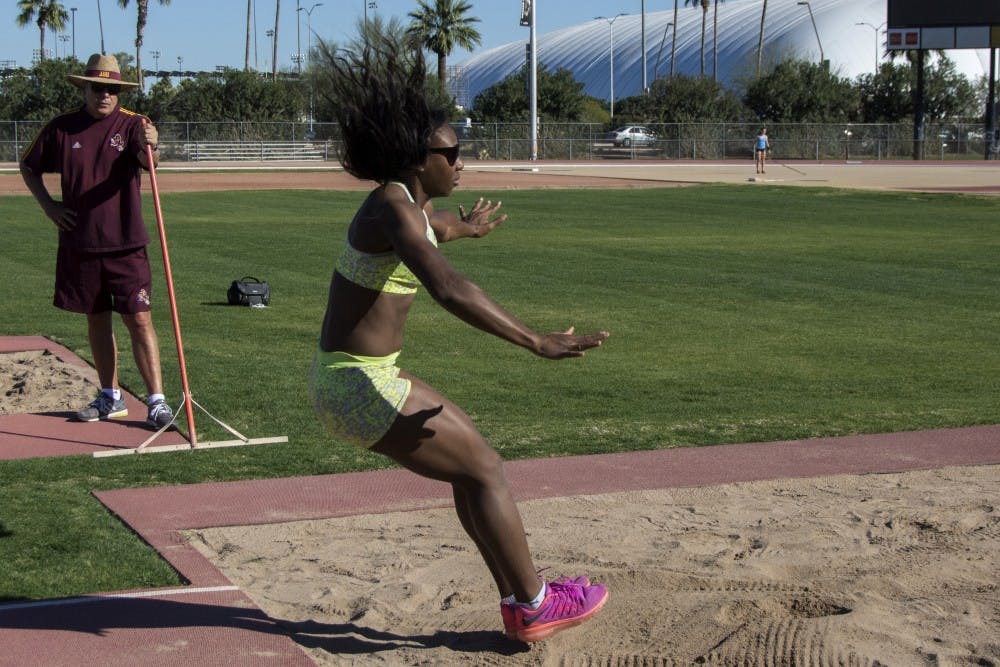Track and field is a sport that has a lot of glamour in certain events, but jumpers aren’t typically high on that list.
“I think it’s part of track and field,” head coach Greg Kraft said. “I think you have to be attractive to the general public and so. In our sport, the glamour event has always been the 100 meters, and then the intrigue with the mile. In field events, people like watching the big guys throw the shot and the pole vaulters because visually, it’s very exciting.”
Kraft feels that this isn’t about how the media covers the sport, but rather how the casual fan pays attention during meets, and what they find interesting. While it’s an unfortunate situation for athletes competing in jumping events, he feels building yourself up as a competitor can help get people's attention.
"I think that our former volunteer coach Dan O’Brien, with the hardships that he endured growing up and the failure he had in ’92 (the Olympics), and … coming back in ’96 and becoming an Olympic champion, I think that’s the kind of story that everyone got behind and really rooted for him," Kraft said. "I don’t take that stuff personally — if a jumper feels slighted, he probably needs to talk to a hammer thrower.”
The jumpers have seen success this season. One of the best jumpers is redshirt junior Tim White. He hasn't had a break from competing this year, as he played football in the fall, but he played both sports at a high level nonetheless. He's won the triple jump in all but two meets, in which he got second and third.
White had only a couple of days to recover from the football season. He told thesundevils.com writer Craig Morgan that he's still attempting to recuperate his legs from the football season, but hopes to get into the top eight before the NCAA tournament begins.
White isn’t the only one who has been performing well so far this season. His jumping mate, senior Josh Dixon, has also had a nice run as he has competed in both the long and triple jump events.
He's placed in the top five in multiple events.
Women's jumper junior Keyasia Tibbs took second place in the triple jump at the Indoor Lumberjack Team Challenge and is consistently in the top five in jumping events.
Many people believe jumpers have an easy road and don't push themselves as much as sprinters or throwers. Tibbs rebutted this mindset.
“We have so much more on our bodies,” Tibbs said. “We impact the ground more, we have so much more force into the ground than regular sprinting, so we have an overbearing effect with our body. Our shins are aching, our knees, our hips — we feel the aftereffect of the practices.”
Jumpers put their bodies under constant pressure. While practicing their leap, they work on perfecting even the smallest of details. Kraft works to perfect the techniques in practice, where the speed is different from the meets.
“It’s really difficult to do because it’s hard to simulate the speed that you have at a competition, much like when you hear football coaches talk about game speed, practice speed," he said. "So it’s very difficult to simulate that, and we like to do that early in the week before we get too fatigued from lifting."
Because of this, athletes rely as heavily on mental training as they do on physical.
“The foundation of it is muscle memory and mental,” Tibbs said. “You have to start with mental first, you have to mentally prepare yourself for the jumps, and to know how far you want to jump, and to know how far you’re capable of. ... You have to start off with that positive mental block. If you’re hurt and you go out with a negative thought, you aren’t going to have a good jump.”
With how much they run, jump and push their bodies to the limits, it comes as no surprise that these athletes get injured throughout the season. With nagging injuries, they need to find a way to contain their pain before the event and instead focus on the task at hand. Tibbs said that there isn't going to be a perfect season.
“There are going to be meets where you’re just feeling horrible, but a part of that is knowing how you feel going into that meet, so taking the precaution and going to see the trainers ... prevent(s) as much pain as you could before going into a meet," she said. "But it’s hard to prevent all of that. So if it does happen, you just have to have that mental mindset and still go into the meet knowing that your legs hurt, but that you still have to do your job.”
Reach the reporter at osoussi@asu.edu or follow @omarksoussi on Twitter.
Like State Press Sports on Facebook and follow @statepresssport on Twitter.




